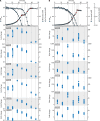Responsiveness of Aromatoleum aromaticum EbN1T to Lignin-Derived Phenylpropanoids
- PMID: 33741621
- PMCID: PMC8208140
- DOI: 10.1128/AEM.03140-20
Responsiveness of Aromatoleum aromaticum EbN1T to Lignin-Derived Phenylpropanoids
Abstract
The betaproteobacterial degradation specialist Aromatoleum aromaticum EbN1T utilizes several plant-derived 3-phenylpropanoids coupled to denitrification. In vivo responsiveness of A. aromaticum EbN1T was studied by exposing nonadapted cells to distinct pulses (spanning 100 µM to 0.1 nM) of 3-phenylpropanoate, cinnamate, 3-(4-hydroxyphenyl)propanoate, or p-coumarate. Time-resolved, targeted transcript analyses via quantitative reverse transcription-PCR of four selected 3-phenylpropanoid genes revealed a response threshold of 30 to 50 nM for p-coumarate and 1 to 10 nM for the other three tested 3-phenylpropanoids. At these concentrations, transmembrane effector equilibration is attained by passive diffusion rather than active uptake via the ABC transporter, presumably serving the studied 3-phenylpropanoids as well as benzoate. Highly substrate-specific enzyme formation (EbA5316 to EbA5321 [EbA5316-21]) for the shared peripheral degradation pathway putatively involves the predicted TetR-type transcriptional repressor PprR. Accordingly, relative transcript abundances of ebA5316-21 are lower in succinate- and benzoate-grown wild-type cells than in an unmarked in-frame ΔpprR mutant. In trans-complementation of pprR into the ΔpprR background restored wild-type-like transcript levels. When adapted to p-coumarate, the three genotypes had relative transcript abundances similar to those of ebA5316-21 despite a significantly longer lag phase of the pprR-complemented mutant (∼100-fold higher pprR transcript level than the wild type). Notably, transcript levels of ebA5316-21 were ∼10- to 100-fold higher in p-coumarate- than succinate- or benzoate-adapted cells across all three genotypes. This indicates the additional involvement of an unknown transcriptional regulator. Furthermore, physiological, transcriptional, and (aromatic) acyl-coenzyme A ester intermediate analyses of the wild type and ΔpprR mutant grown with binary substrate mixtures suggest a mode of catabolite repression of superior order to PprR.IMPORTANCE Lignin is a ubiquitous heterobiopolymer built from a suite of 3-phenylpropanoid subunits. It accounts for more than 30% of the global plant dry material, and lignin-related compounds are increasingly released into the environment from anthropogenic sources, i.e., by wastewater effluents from the paper and pulp industry. Hence, following biological or industrial decomplexation of lignin, vast amounts of structurally diverse 3-phenylpropanoids enter terrestrial and aquatic habitats, where they serve as substrates for microbial degradation. This raises the question of what signaling systems environmental bacteria employ to detect these nutritionally attractive compounds and to adjust their catabolism accordingly. Moreover, determining in vivo response thresholds of an anaerobic degradation specialist such as A. aromaticum EbN1T for these aromatic compounds provides insights into the environmental fate of the latter, i.e., when they could escape biodegradation due to too low ambient concentrations.
Keywords: (aromatic) acyl-CoA ester; Aromatoleum aromaticum EbN1T; anaerobic degradation; deletion mutation; diauxie; phenylpropanoids; physiology; regulation; responsiveness; sensory system; transcript profiling.
Copyright © 2021 American Society for Microbiology.
Figures








Similar articles
-
Proteogenomic evidence for β-oxidation of plant-derived 3-phenylpropanoids in "Aromatoleum aromaticum" EbN1.Proteomics. 2012 May;12(9):1402-13. doi: 10.1002/pmic.201100279. Proteomics. 2012. PMID: 22589189
-
Nanomolar Responsiveness of an Anaerobic Degradation Specialist to Alkylphenol Pollutants.J Bacteriol. 2020 Feb 11;202(5):e00595-19. doi: 10.1128/JB.00595-19. Print 2020 Feb 11. J Bacteriol. 2020. PMID: 31843798 Free PMC article.
-
Towards the Response Threshold for p-Hydroxyacetophenone in the Denitrifying Bacterium "Aromatoleum aromaticum" EbN1.Appl Environ Microbiol. 2018 Aug 31;84(18):e01018-18. doi: 10.1128/AEM.01018-18. Print 2018 Sep 15. Appl Environ Microbiol. 2018. PMID: 29959253 Free PMC article.
-
The Catabolic Network of Aromatoleum aromaticum EbN1T.Microb Physiol. 2024;34(1):1-77. doi: 10.1159/000534425. Epub 2023 Oct 10. Microb Physiol. 2024. PMID: 37816339 Review.
-
Towards habitat-oriented systems biology of "Aromatoleum aromaticum" EbN1: chemical sensing, catabolic network modulation and growth control in anaerobic aromatic compound degradation.Appl Microbiol Biotechnol. 2014 Apr;98(8):3371-88. doi: 10.1007/s00253-013-5466-9. Epub 2014 Feb 4. Appl Microbiol Biotechnol. 2014. PMID: 24493567 Review.
Cited by
-
A pH-dependent shift of redox cofactor specificity in a benzyl alcohol dehydrogenase of aromatoleum aromaticum EbN1.Appl Microbiol Biotechnol. 2024 Jul 8;108(1):410. doi: 10.1007/s00253-024-13225-z. Appl Microbiol Biotechnol. 2024. PMID: 38976076 Free PMC article.
-
The etherase system of Novosphingobium sp. MBES04 functions as a sensor of lignin fragments through phenylpropanone production to induce specific transcriptional responses.Environ Microbiol Rep. 2024 Feb;16(1):e13210. doi: 10.1111/1758-2229.13210. Epub 2023 Nov 10. Environ Microbiol Rep. 2024. PMID: 37950419 Free PMC article.
-
A Novel Coenzyme A Analogue in the Anaerobic, Sulfate-Reducing, Marine Bacterium Desulfobacula toluolica Tol2T.Chembiochem. 2023 Jan 17;24(2):e202200584. doi: 10.1002/cbic.202200584. Epub 2022 Dec 8. Chembiochem. 2023. PMID: 36331165 Free PMC article.
-
Systems Biology of Aromatic Compound Catabolism in Facultative Anaerobic Aromatoleum aromaticum EbN1T.mSystems. 2022 Dec 20;7(6):e0068522. doi: 10.1128/msystems.00685-22. Epub 2022 Nov 29. mSystems. 2022. PMID: 36445109 Free PMC article.
References
Publication types
MeSH terms
Substances
Supplementary concepts
LinkOut - more resources
Full Text Sources
Other Literature Sources

